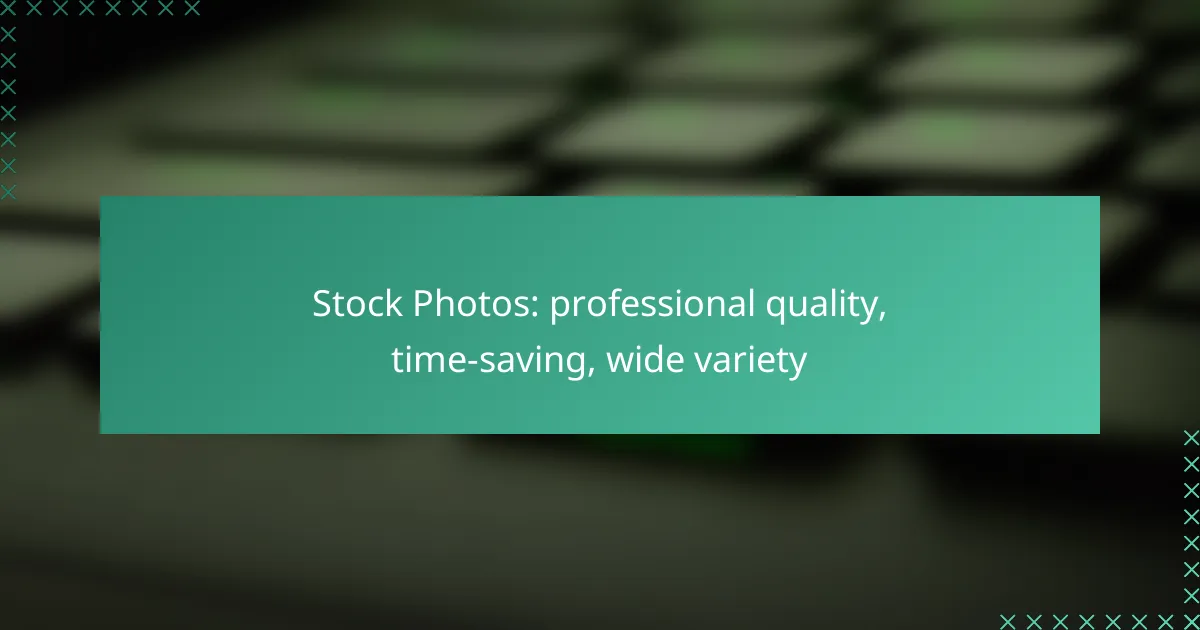Stock photos are an invaluable resource for businesses and individuals seeking professional-quality visuals without the hassle of organizing photoshoots. With a wide variety of options available online, these images cater to diverse needs and budgets, ensuring that the perfect visuals are just a click away. By utilizing stock photos, users can save time and enhance their marketing and content efforts efficiently.

Where to find professional stock photos in the UK?
In the UK, professional stock photos can be sourced from various online platforms that offer high-quality images for commercial use. These platforms provide a wide variety of options, catering to different needs and budgets, making it easy to find the perfect visuals for any project.
Shutterstock
Shutterstock is one of the largest stock photo libraries, featuring millions of images, videos, and music tracks. Users can purchase images through subscription plans or on-demand credits, allowing flexibility based on usage needs. It’s known for its extensive collection and user-friendly search functionality.
When using Shutterstock, consider the licensing options available. Standard licenses cover most uses, but for larger projects or specific needs, an enhanced license may be necessary. Always check the terms to ensure compliance with your intended use.
Adobe Stock
Adobe Stock integrates seamlessly with Adobe Creative Cloud applications, making it a convenient choice for designers and creatives. Users can access millions of high-quality images, graphics, and videos, with options for subscription or credit packs.
Adobe Stock offers a unique feature called “Visual Search,” allowing users to find similar images based on a reference image. This can save time in the search process and help maintain a consistent visual style across projects.
iStock
iStock, a subsidiary of Getty Images, provides a diverse range of stock photos, illustrations, and videos. Users can choose between credit packs or subscription plans, with options for both standard and exclusive content. The platform is known for its affordable pricing and high-quality images.
iStock often runs promotions, so it’s worth checking for discounts or special offers. Additionally, the “Essentials” collection features budget-friendly options without compromising quality, making it ideal for small businesses or freelancers.
Getty Images
Getty Images is renowned for its premium stock photos, often used by major publications and corporations. It offers a vast library of high-quality images, including editorial content. Users can purchase images through rights-managed or royalty-free licensing options.
Due to the premium nature of Getty Images, prices can be higher than other platforms. However, the quality and exclusivity of the content may justify the investment for businesses seeking standout visuals for marketing or branding.
Depositphotos
Depositphotos offers a large collection of stock photos, vectors, and videos at competitive prices. Users can select from subscription plans or pay-as-you-go options, making it accessible for various budgets. The platform is user-friendly, with advanced search filters to streamline the image selection process.
Depositphotos frequently updates its library with new content, ensuring users have access to fresh and relevant images. It’s a solid choice for those looking for quality visuals without breaking the bank, especially for small to medium-sized projects.

How do stock photos save time for businesses?
Stock photos save time for businesses by providing immediate access to a wide range of high-quality images, eliminating the lengthy process of organizing photoshoots. This allows companies to quickly find and use visuals that enhance their marketing and content efforts.
Instant access to diverse images
Stock photo libraries offer thousands of images across various categories, styles, and themes, enabling businesses to find the perfect visual for any project in minutes. This vast selection helps ensure that companies can represent their brand effectively without the hassle of creating custom images.
Many stock photo platforms allow users to search by keywords, making it easy to locate specific types of images. For example, a business looking for images related to technology can quickly filter through relevant options, saving hours of searching.
Reduced need for photoshoots
By utilizing stock photos, businesses can significantly cut down on the time and resources required for photoshoots. Organizing a photoshoot involves planning, hiring photographers, and coordinating schedules, which can take weeks or even months.
In contrast, stock photos are ready to use immediately, allowing companies to focus on other important tasks. This is particularly beneficial for small businesses or startups that may not have the budget or time for extensive photography projects.
Streamlined content creation
Stock photos facilitate faster content creation by providing ready-to-use visuals that can be easily integrated into marketing materials, websites, and social media posts. This efficiency helps businesses maintain a consistent flow of content without delays.
Additionally, many stock photo services offer subscription plans that allow for unlimited downloads, further speeding up the process. By having a library of images at their fingertips, teams can quickly adapt their content strategies to current trends or campaigns, ensuring they stay relevant in a competitive market.

What are the benefits of using stock photos?
Using stock photos offers significant advantages for businesses and individuals looking to enhance their visual content. These benefits include cost savings, access to high-quality images, and a diverse range of themes to suit various needs.
Cost-effective marketing
Stock photos provide a budget-friendly alternative to hiring professional photographers for custom images. Prices for stock images can range from a few dollars to a couple of hundred, depending on licensing and exclusivity.
By utilizing stock photos, businesses can allocate their marketing budgets more efficiently, allowing for investment in other areas such as advertising or product development. This approach is particularly beneficial for startups and small businesses with limited resources.
High-quality visuals
Stock photos are often produced by skilled photographers and designers, ensuring a high standard of quality. Many stock photo platforms offer images that are suitable for both digital and print media, meeting various resolution requirements.
When selecting stock images, look for those that have been professionally edited and are available in multiple formats. This ensures that the visuals will maintain their quality across different applications, from websites to brochures.
Wide variety of themes
Stock photo libraries boast extensive collections covering a multitude of themes, from business and technology to nature and lifestyle. This variety allows users to find images that perfectly align with their brand message or project requirements.
To effectively utilize stock photos, consider creating a list of themes relevant to your content strategy. This can help streamline the search process and ensure that the images selected resonate with your target audience.

What criteria should you consider when selecting stock photos?
When selecting stock photos, consider image resolution, licensing terms, and relevance to your brand. These factors ensure that the images meet quality standards, comply with legal requirements, and align with your marketing goals.
Image resolution
Image resolution is crucial for maintaining quality across various platforms. High-resolution images (typically 300 DPI for print and 72 DPI for web) ensure clarity and professionalism. Always check the resolution of stock photos to avoid pixelation, especially for larger displays or printed materials.
For web use, images should generally be optimized for faster loading times while still being visually appealing. Aim for resolutions that balance quality and performance, usually in the range of 1200 to 2000 pixels wide for most website applications.
Licensing terms
Understanding licensing terms is essential to avoid legal issues. Stock photos typically come with different licenses, such as royalty-free or rights-managed. Royalty-free images allow for unlimited use after a one-time fee, while rights-managed images may have restrictions based on usage, duration, or geography.
Always read the licensing agreement carefully to ensure compliance with usage rights. Some licenses may require attribution or limit the number of copies you can distribute, which can impact your marketing strategy.
Relevance to brand
Selecting stock photos that resonate with your brand identity is vital for effective communication. The images should reflect your brand’s values, tone, and target audience. For example, a tech company might prefer sleek, modern visuals, while a wellness brand may opt for calming, nature-focused imagery.
Consider creating a mood board to visualize how different images align with your brand’s aesthetic. This can help streamline the selection process and ensure consistency across all marketing materials.

How do stock photo subscriptions work?
Stock photo subscriptions provide access to a library of professional-quality images for a recurring fee. Users can download a specified number of images per month or year, making it a cost-effective solution for businesses and individuals needing visuals.
Monthly vs. annual plans
Monthly plans offer flexibility, allowing users to pay for access on a short-term basis. This is ideal for those who may need images sporadically or want to test a service before committing long-term.
Annual plans typically provide a lower cost per image compared to monthly subscriptions, making them more economical for frequent users. For example, a monthly plan might cost around $30, while an annual plan could average $300, effectively reducing the monthly rate.
When choosing between plans, consider your usage frequency and budget. If you anticipate needing a steady stream of images, an annual plan may save you money in the long run. However, if your needs are unpredictable, a monthly plan offers the necessary flexibility.
